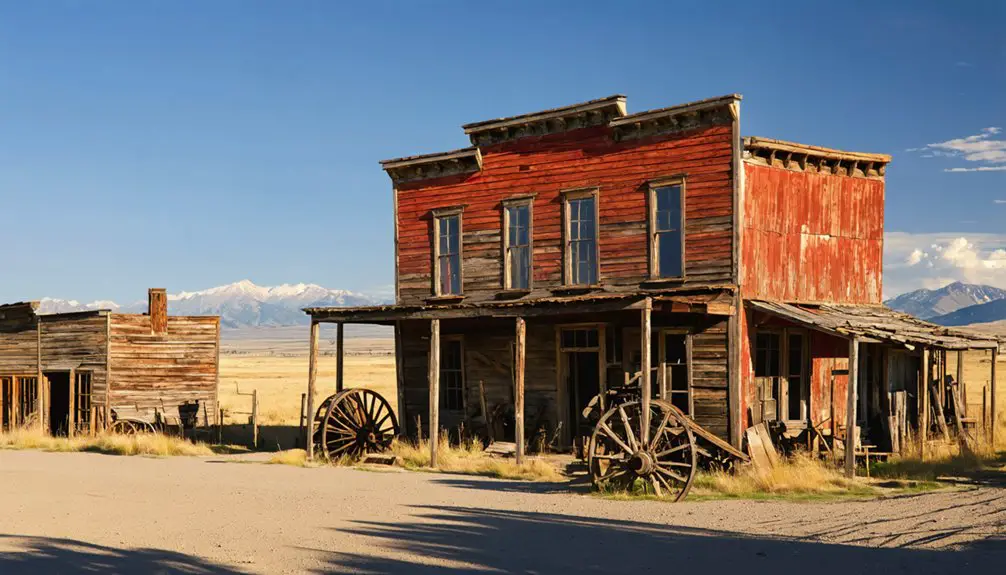You’ll discover Pony, Montana, a living ghost town named after Civil War veteran Smith “Pony” McComsey, who struck gold here in 1867. During its peak in the late 1870s, nearly 5,000 residents flocked to this mining boomtown, which produced $5 million in precious ore between 1870 and 1922. Today, you can explore the preserved 19th-century buildings, including the original 1869 iSell mercantile store, while a small community of 100 residents maintains the town’s rich mining heritage.
Key Takeaways
- Pony is not a complete ghost town, maintaining a small population of about 100 residents and preserving many original structures.
- The town peaked during the 1870s gold mining era with 5,000 residents before declining after mining operations ceased in 1922.
- Historic buildings still stand, including the 1869 iSell mercantile store and Elling Morris mill, which operated until 1926.
- The Pony Homecoming Club actively preserves the town’s mining heritage through a museum and annual cultural events.
- Located at 5,525 feet elevation, Pony’s 192-acre historic district features abandoned mines and weathered structures from its mining heyday.
The Legend Behind the Name
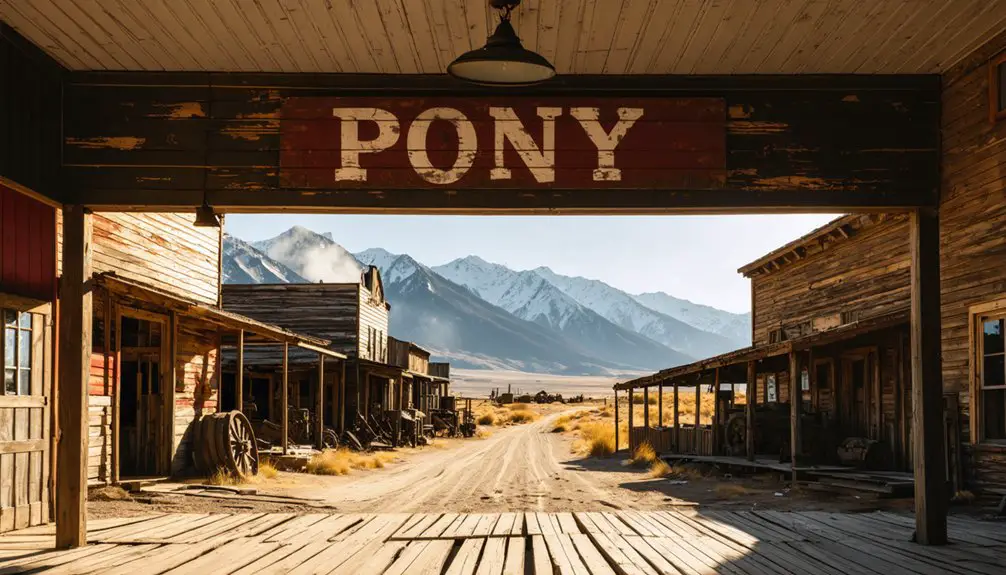
While many Montana ghost towns bear names reflecting grand aspirations or geographic features, Pony‘s origin stems from a humble Civil War veteran and prospector named Smith McComsey. Standing just over five feet tall, McComsey’s diminutive stature earned him the nickname “Pony” among fellow miners.
A small man’s nickname birthed a Montana ghost town, proving how the most modest origins can shape lasting history.
You’ll find his legacy etched across the landscape, from the town itself to surrounding geographic features, though much of his personal story remains shrouded in mystery.
As a drifter and gold panner, McComsey wandered various camps before striking gold beneath Hollowtop Mountain. Local folklore tells of him discovering the “Strawberry Mine” after throwing his pickaxe in frustration into a patch of wild berries.
This tale, like many aspects of nickname origins and prospector folklore, blends fact with frontier legend, creating an enduring mystique that defines Pony’s character. Similar to Virginia City’s transformation from bustling mining town to tourist destination, Pony now draws visitors seeking to explore its rich cultural history.
Gold Rush Origins and Early Settlement
You’ll find the origins of Pony’s mining camp traced back to 1867, when Civil War veteran Smith “Pony” McComsey first staked his claims along Pony Creek after prospecting northeast from Alder Gulch.
In 1868, McComsey returned with a partner to establish a small mining settlement known as Pony Gulch, setting the foundation for what would become a thriving gold mining district.
Mining Camp Beginnings
After the discovery of gold by Smith McComsey near Alder Gulch in 1867, the foundations of Pony, Montana began taking shape along Pony Creek.
You’d have found the initial mining techniques focused on placer deposits, though this early camp wouldn’t last through the 1870s. The economic impact truly took hold when Jerome Bales and George Kendall struck gold at the Ned mine in 1874, marking the shift to lode mining.
As prospectors uncovered rich veins like the Willow Creek and Strawberry lodes, you’d have witnessed Pony transform into a bustling camp by 1876.
The settlement quickly attracted merchants, with the iSell mercantile opening in 1869. Civil War veterans, including McComsey himself, formed the backbone of this hardy mining community, where free gold yielded $20 to $100 per ton.
Pony McComsey’s Discovery Legacy
The legacy of Smith “Pony” McComsey, a diminutive Civil War veteran standing just over five feet tall, shaped both the naming and founding of Pony, Montana.
You’ll find his prospecting techniques laid the groundwork for the area’s golden future when he first staked his claim in 1867, returning with a partner in 1868 to establish what would become Pony Gulch.
Like many prospectors who traveled to Montana via the Missouri River route, McComsey’s impact resonates through time, from the initial placer claims to the dramatic lode discoveries that followed.
When Jerome Bales and George Kendall uncovered the Ned mine and Willow Creek vein, they built upon McComsey’s pioneering work.
The subsequent discoveries of the Keystone, Crevice, and Strawberry lodes transformed the region, yielding an impressive $5 million in gold ore between 1870-1880.
Mining Glory Days: 1870-1922
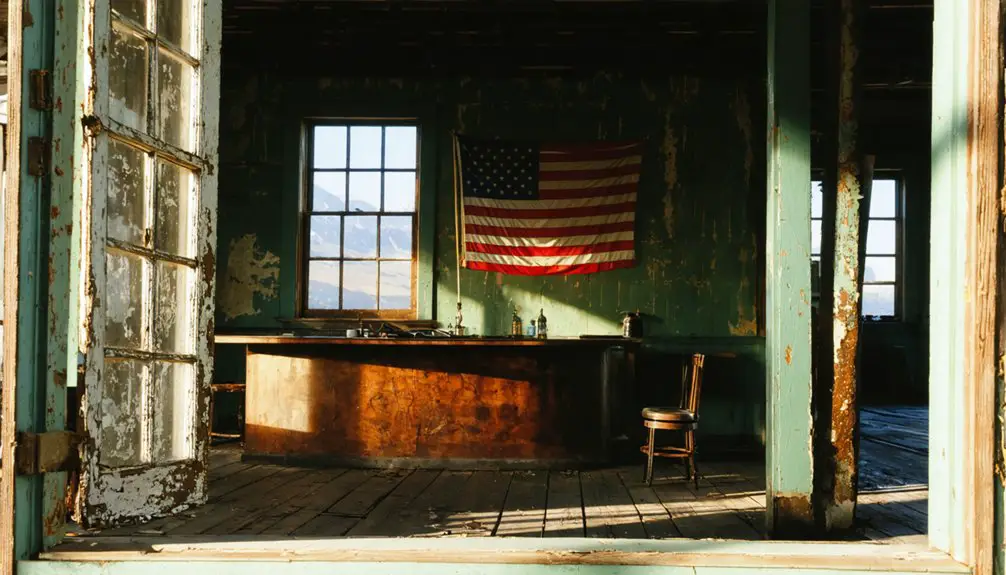
During Pony’s golden era from 1870 to 1922, prospectors extracted an estimated $5 million in precious ore from major quartz veins like the Ned, Willow Creek, Keystone, Crevice, and Strawberry lodes.
You’d have found gold production particularly rich at shallow depths, with the Strawberry lode yielding $20 to $100 per ton just 14 feet below ground. The boom drew nearly 5,000 residents to this freedom-seeking frontier town. Much like the Drumlummon Mine sale of 1883 that brought $1.63 million, mining claims in Pony attracted significant eastern investment. Like other successful Montana districts, Pony’s mines produced over 100,000 ounces of gold during its peak years.
In 1883, eastern investors built the ambitious 100-stamp Elling-Morris Mill, betting on high-grade deposits that never materialized.
As ore quality diminished and accessible mines depleted, mining decline set in by the early 1900s. A devastating fire in 1920 destroyed key infrastructure, and by 1922, Pony’s mining operations had completely ceased, ending its prosperous chapter.
Notable Mines and Mining Operations
You’ll find Pony’s earliest mining success stories in the Ned and Willow Creek mines, discovered by Jerome W. Bales and George A. Kendall, who focused on rich quartz deposits considered the district’s motherlode.
Soon after, George Moreland struck it rich with his Crevice and Strawberry lode mines about two miles above Pony’s townsite, where he discovered gold chunks so dense they could be mashed with a pestle.
These successful operations marked Pony’s significant shift from simple placer mining, which relied on pans and rockers, to more sophisticated hard rock mining that would sustain the town’s economy for decades.
Lode Mining Success Stories
Notable success stories from Pony’s lode mining history began in 1874 when Jerome W. Bales and George A. Kendall struck gold at the Ned mine, launching a significant mining boom.
The district’s quartz deposits proved to be the motherlode, confirming the source of the area’s rich placer gold.
You’ll find some of the most remarkable lode mining techniques emerged when George Moreland discovered the Strawberry lode, yielding phenomenally rich ore worth up to $100 per ton.
- Picture massive quartz veins cutting through ancient gneiss rock, glinting with gold at 7,402 feet elevation
- Envision early miners crushing strawberry patch rocks so rich with gold they could extract it by hand
- See the sprawling network of claims stretching across the Tobacco Root Mountains, marking the district’s ambitious reach
Early Placer Mining Sites
Gold fever struck Pony district in the early 1870s when Smith “Pony” McComsey’s initial placer discoveries sparked a rush of mining activity.
You’ll find the earliest successful claims at the Ned mine, where Jerome W. Bales and George A. Kendall first struck placer gold, followed by William Robson’s discovery of the promising Keystone vein.
If you’d venture two miles above Pony town, you’d discover George Moreland’s legendary finds: the Crevice and Strawberry lodes, with the latter hidden among wild berry patches.
These quartz deposits proved to be the motherlodes feeding the district’s rich placer gold deposits.
Mining techniques evolved from simple panning to more sophisticated operations, yielding about five million dollars in ore between 1870-1880.
The district’s success attracted thousands of freedom-seeking prospectors, transforming Pony into a bustling mining camp.
Preserving a Mining Legacy
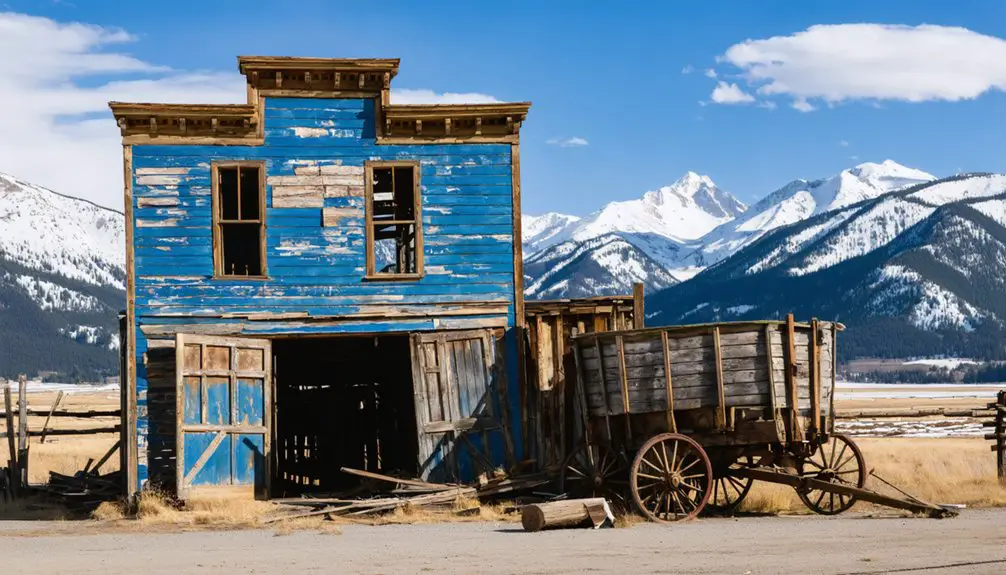
While many Western ghost towns have faded into obscurity, Pony, Montana stands as a proof of careful historical preservation.
Through community storytelling and dedicated historical preservation efforts, you’ll find a town that’s kept its 19th-century character alive. The metal sculpture of a bucking pony on the hillside pays tribute to the town’s namesake, while the original 1869 iSell mercantile store and Elling Morris mill showcase authentic mining-era architecture.
- Walk the streets where Smith “Pony” McComsey first struck gold, with buildings still arranged as they were during the 1870s boom.
- Explore the preserved Elling Morris processing mill, where low-grade ore once rumbled through stamps from 1884 to 1926.
- Visit local galleries featuring historic photographs and artifacts that document the town’s rich mining heritage.
Each year, residents host events celebrating their mining roots, ensuring Pony’s legacy endures for future generations.
Life in Modern-Day Pony
Today’s Pony bears little resemblance to its bustling mining heyday, yet its character remains distinctly Western. You’ll find just over 100 residents spread across the town’s modest 1.34 square miles, with most being retirees – the median age hovers around 66.
The local economy reflects this aging population, with most working residents commuting about 45 minutes to jobs elsewhere.
Despite its ghost town status, Pony maintains a stable community. You’ll notice the high homeownership rate of 81% and median household incomes reaching $54,296.
The town’s 95 historic buildings stand as evidence to its mining heritage, while modern-day residents enjoy relatively comfortable living standards with low poverty rates and property values around $243,800 – typical for rural Montana.
Natural Surroundings and Geography
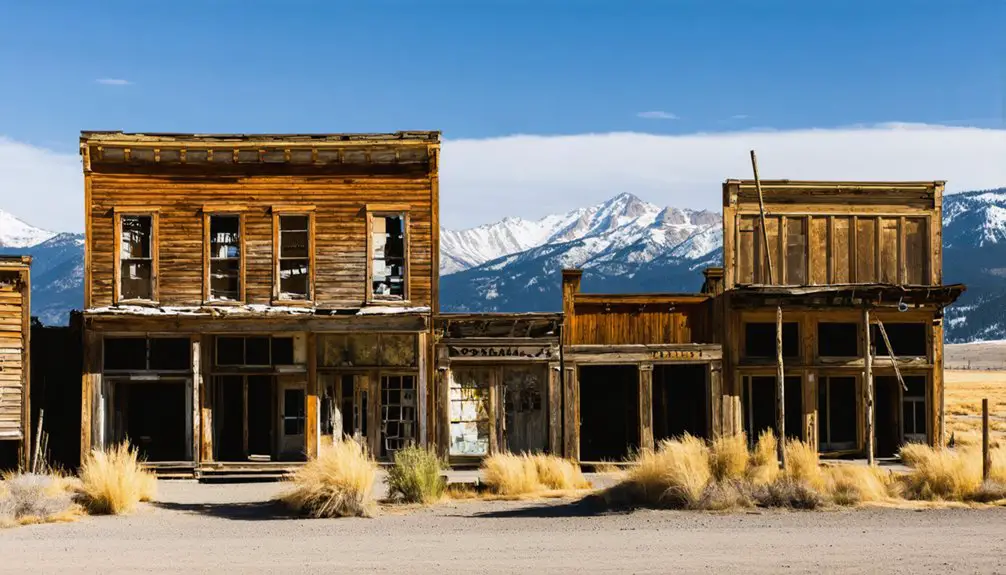
Tucked away in northeastern Madison County, Pony rests at an elevation of 5,525 feet against the dramatic backdrop of the Tobacco Root Mountains.
You’ll find yourself surrounded by mountain ecology that’s shaped both the town’s history and present-day character. The dense conifer forests and historical flora, including wild strawberry patches near old mining lodes, create a pristine natural setting that’s remained largely unchanged since the mining era.
- Hollowtop Mountain towers above, its rugged peaks harboring the quartz and gold veins that once drew prospectors.
- Willow Creek’s crystal waters cut through the landscape, where placer gold deposits shaped early settlement patterns.
- Natural mountain foliage blankets the 192-acre historic district, weaving between weathered structures and abandoned mines.
Community Events and Cultural Heritage
Despite its small size, Pony maintains a vibrant cultural legacy through the dedicated efforts of the Pony Homecoming Club, established in 1961 by passionate residents determined to preserve their town’s rich heritage.
Over 100 members actively maintain historic buildings and operate a museum showcasing the region’s mining and pioneer history.
Dedicated volunteers preserve Pony’s rich heritage through careful stewardship of historic sites and museum curation highlighting local mining roots.
You’ll find community engagement at its finest during “Pony Days,” where cultural festivals celebrate the town’s namesake, Civil War veteran “Pony” McComsey.
These events feature historical reenactments, riding exhibitions, and educational activities that bring the gold rush era to life.
The town’s preservation initiatives include oral history collection and archival research, while regular cultural workshops guarantee the survival of local traditions.
Pony’s heritage tourism efforts have made it a model for small-town cultural preservation in Montana’s historic mining districts.
Frequently Asked Questions
What Happened to Pony Mccomsey After the Town Was Established?
You’ll find McComsey’s trail goes cold after he helped establish the town. His legacy lives on through Pony’s name, but records don’t detail his later life beyond founding.
Are There Any Remaining Gold Deposits Worth Mining in Pony Today?
Like a miner’s pan holding mere flecks, you’ll find limited gold prospecting potential today. While deposits exist, they aren’t commercially viable with current mining technology, though small-scale exploration remains possible.
What Was the Average Salary of Miners During Pony’s Peak Years?
You’d have found mining wages ranging from $2-4 daily during Pony’s peak years (1870s-1920s), translating to roughly $500-1,200 annually, with skilled underground workers earning the highest economic impact from their labor.
Did Any Famous Outlaws or Notable Historical Figures Visit Pony?
Like gold dust scattered in a pan, you won’t find records of famous outlaws or notable historical figures visiting Pony. The town’s story centers on everyday miners seeking fortune.
How Many Original Buildings From the Mining Era Still Stand Today?
You’ll find around 95 original buildings from the mining heritage era still standing today, preserved within the National Register’s Historic District, with dedicated historic preservation efforts maintaining their authentic character.
References
- https://nbcmontana.com/news/instagram/pony-town-named-for-civil-war-prospector-keeps-colorful-history-alive
- https://www.youtube.com/watch?v=dg4e5s_Kork
- http://www.ghosttowngallery.com/htme/pony.htm
- https://westernmininghistory.com/towns/montana/pony/
- https://en.wikipedia.org/wiki/Pony
- https://www.montanapictures.net/pony-and-harrison-montana-montanapictures-net/
- https://www.ghosttowns.com/states/mt/pony.html
- https://sherilyndecter.com/virginia-city-from-ghost-town-to-tourist-mecca/
- https://www.saveur.com/pony-bar-pony-montana/
- https://www.mtmemory.org/nodes/view/128599
